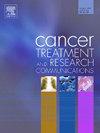免疫检查点抑制剂治疗非小细胞肺癌脑转移的疗效和安全性
IF 2.4
Q3 Medicine
引用次数: 0
摘要
对于接受免疫检查点抑制剂(ICIs)治疗的无靶向致癌驱动因素的非小细胞肺癌(NSCLC)患者无症状脑转移(aBM)的最佳放疗时间(RT)仍不清楚。本研究旨在评估先期(U)-RT联合ICIs治疗aBM的疗效和安全性。方法回顾性分析2016年至2021年在国家癌症中心东医院连续接受含ici化疗的非小细胞肺癌aBM患者。U-RT组定义为在第一个ICI周期之前或期间接受aBM放疗的患者,而非U-RT组则相反。结果在筛选的324例NSCLC和aBM患者中,54例入组,其中U-RT组和非U-RT组分别为34例和20例。U-RT组和非U-RT组的中位总生存期分别为27.5个月和13.8个月(风险比[HR] = 0.40, 95%可信区间[CI] 0.19-0.87),中位无颅进展生存期分别为9.2个月和6.0个月(HR = 0.50, 95% CI 0.25-0.98)。U-RT组aBM进展率明显低于非U-RT组(P = 0.04)。在使用倾向评分调整的多变量分析中,U-RT是一个独立的预后因素(HR = 0.42, 95% CI 0.18-0.96)。尽管在U-RT组和非U-RT组中分别有47%和35%的患者观察到严重不良事件,但没有发生与治疗相关的死亡。结论与未加U-RT的ICIs相比,联合U-RT的ICIs对aBM具有更高的疗效和可接受的耐受性。我们的发现应该在未来的前瞻性试验中得到证实。本文章由计算机程序翻译,如有差异,请以英文原文为准。
Efficacy and safety of upfront radiotherapy with immune checkpoint inhibitors for brain metastasis in non-small cell lung cancer
Introduction
The optimal timing of radiotherapy (RT) for asymptomatic brain metastasis (aBM) in patients with non-small cell lung cancer (NSCLC) without targetable oncogenic drivers treated with immune checkpoint inhibitors (ICIs) remains unclear. This study aimed to assess the efficacy and safety of upfront (U)-RT combined with ICIs for aBM.
Methods
We retrospectively reviewed consecutive patients with aBM from NSCLC who received ICI-containing chemotherapy at National Cancer Center Hospital East between 2016 and 2021. The U-RT group was defined patients who received RT for aBM before or during the first ICI cycle, and the non-U-RT group otherwise.
Results
Of the 324 patients with NSCLC and aBM screened, 54 were enrolled, with 34 and 20 patients in the U-RT and non-U-RT groups, respectively. The median overall survival was 27.5 and 13.8 months (hazard ratio [HR] = 0.40, 95 % confidence interval [CI] 0.19–0.87), respectively, and median cranial progression-free survival was 9.2 and 6.0 months (HR = 0.50, 95 % CI 0.25–0.98), respectively, in the U-RT and non-U-RT groups. The U-RT group showed a significantly lower aBM progression rate than the non-U-RT group (P = 0.04). U-RT was an independent prognostic factor in the multivariate analysis using propensity score adjustment (HR = 0.42, 95 % CI 0.18–0.96). Although severe adverse events were observed in 47 % and 35 % of patients in the U-RT and non-U-RT groups, respectively, no treatment-related deaths occurred.
Conclusions
ICIs with U-RT demonstrated higher efficacy with acceptable tolerability for aBM than ICIs without U-RT. Our findings should be confirmed in future prospective trials.
求助全文
通过发布文献求助,成功后即可免费获取论文全文。
去求助
来源期刊

Cancer treatment and research communications
Medicine-Oncology
CiteScore
4.30
自引率
0.00%
发文量
148
审稿时长
56 days
期刊介绍:
Cancer Treatment and Research Communications is an international peer-reviewed publication dedicated to providing comprehensive basic, translational, and clinical oncology research. The journal is devoted to articles on detection, diagnosis, prevention, policy, and treatment of cancer and provides a global forum for the nurturing and development of future generations of oncology scientists. Cancer Treatment and Research Communications publishes comprehensive reviews and original studies describing various aspects of basic through clinical research of all tumor types. The journal also accepts clinical studies in oncology, with an emphasis on prospective early phase clinical trials. Specific areas of interest include basic, translational, and clinical research and mechanistic approaches; cancer biology; molecular carcinogenesis; genetics and genomics; stem cell and developmental biology; immunology; molecular and cellular oncology; systems biology; drug sensitivity and resistance; gene and antisense therapy; pathology, markers, and prognostic indicators; chemoprevention strategies; multimodality therapy; cancer policy; and integration of various approaches. Our mission is to be the premier source of relevant information through promoting excellence in research and facilitating the timely translation of that science to health care and clinical practice.
 求助内容:
求助内容: 应助结果提醒方式:
应助结果提醒方式:


